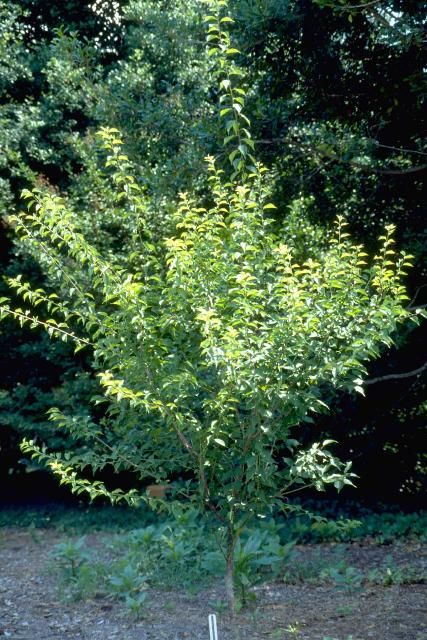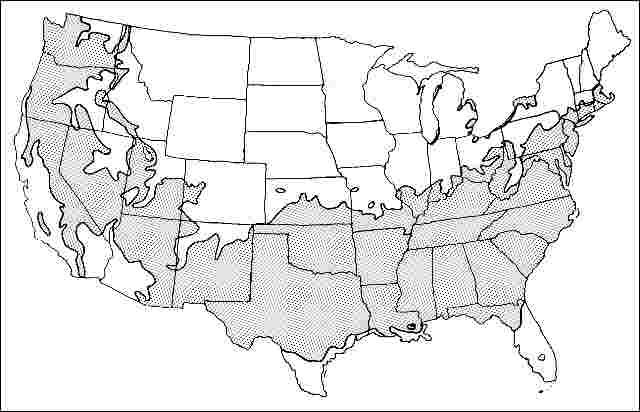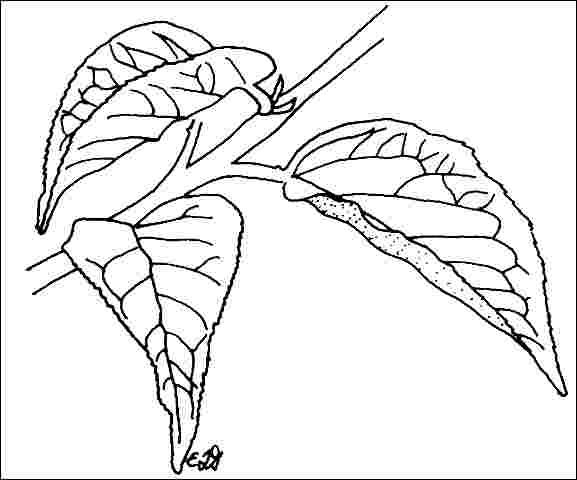Introduction
Japanese Flowering Apricot may be the longest-lived of the flowering fruit trees eventually forming a gnarled, picturesque, 20-foot-tall tree. Appearing during the winter on bare branches are the multitude of small, fragrant, pink flowers which add to the uniqueness of the tree's character. The small yellow fruits which follow the blooms are inedible but attractive.

Credit: Ed Gilman
General Information
Scientific name: Prunus mume
Pronunciation: PROO-nus MEW-may
Common name(s): Japanese Apricot
Family: Rosaceae
USDA hardiness zones: 6A through 8B (Fig. 2)
Origin: not native to North America
Invasive potential: little invasive potential
Uses: specimen; deck or patio; highway median
Availability: somewhat available, may have to go out of the region to find the tree

Description
Height: 12 to 20 feet
Spread: 15 to 20 feet
Crown uniformity: irregular
Crown shape: round, vase
Crown density: moderate
Growth rate: moderate
Texture: fine
Foliage
Leaf arrangement: alternate (Fig. 3)
Leaf type: simple
Leaf margin: serrate
Leaf shape: ovate
Leaf venation: pinnate
Leaf type and persistence: deciduous
Leaf blade length: 2 to 4 inches
Leaf color: green
Fall color: no color change
Fall characteristic: not showy

Flower
Flower color: pink
Flower characteristics: showy
Fruit
Fruit shape: round
Fruit length: 1 to 3 inches
Fruit covering: fleshy
Fruit color: yellow
Fruit characteristics: attracts birds; showy; fruit/leaves not a litter problem
Trunk and Branches
Trunk/bark/branches: branches droop; not showy; typically multi-trunked; thorns
Pruning requirement: needed for strong structure
Breakage: resistant
Current year twig color: green
Current year twig thickness: thin
Wood specific gravity: unknown
Culture
Light requirement: full sun
Soil tolerances: clay; sand; loam; acidic; well-drained
Drought tolerance: moderate
Aerosol salt tolerance: unknown
Other
Roots: not a problem
Winter interest: yes
Outstanding tree: yes
Ozone sensitivity: sensitive
Verticillium wilt susceptibility: susceptible
Pest resistance: sensitive to pests/diseases
Use and Management
The tree is well suited for planting near the patio or deck. Locate it where it will receive sun on all sides of the tree to develop a uniform crown, for it becomes one sided when exposed to sun on only one side. It would add color to the shrub border during the winter when most other plants are dormant. It makes a very nice specimen in a lawn or planted as a group to accent a building entrance.
Japanese Flowering Apricot should be grown in full sun on well-drained, fertile, acid soils. Not adapted to poor or dry soils. Plants will require heavy pruning to flower their best. The tree is now being grown by a handful of nurseries, and some nurseries are growing a cultivar or two. Adhere to cultural requirements for best growth.
Cultivars include: `Bonita', semidouble rose-red blossoms; `Dawn', large ruffled double pink; `Peggy Clarke', double deep rose; `Rosemary Clarke', double white flowers with red calyces; and `W.B. Clarke', double pink flowers, weeping plant form. None are really available in large quantities.
Propagation is by cuttings or by seed.
Pests
Aphids cause distortion of new growth, deposits of honeydew, and sooty mold.
Borers attack stressed trees. Keep trees healthy with regular fertilizer applications.
Scales of several types infest the cherries. Horticultural oil is used to control overwintering stages.
Spider mites cause yellowing or stippling but they are very difficult to see.
Tent caterpillars make large webbed nests in trees then eat the foliage. One defoliation may not be serious and small nests can be pruned out and destroyed. Use Bacillus thuringiensis when the insects are first seen and are still small.
Diseases
No diseases are of major concern.